The Florida Forests
Habitat types associated with
woodlands around Cocoa in Florida
There are six basic woodland habitat types
in Florida, commonly called 'Hammocks'. You will encounter most of
these throughout your horse ride.
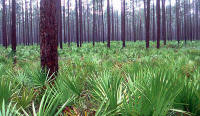 Flatwoods in Florida include several
related communities that are characterized by a relatively open
canopy of pines, an extensive low shrub layer, and a variable
herbaceous layer. Scrubby flatwoods occur on moderately well drained
soil, intermediate between scrub and mesic flatwoods conditions.
They have an understory of scrub oaks and other shrubs and an open
canopy of longleaf pine (Pinus palustris) or South Florida slash
pine (Pinus elliottii var. densa). Flatwoods in Florida include several
related communities that are characterized by a relatively open
canopy of pines, an extensive low shrub layer, and a variable
herbaceous layer. Scrubby flatwoods occur on moderately well drained
soil, intermediate between scrub and mesic flatwoods conditions.
They have an understory of scrub oaks and other shrubs and an open
canopy of longleaf pine (Pinus palustris) or South Florida slash
pine (Pinus elliottii var. densa).
Mesic and hydric flatwoods occur on low, flat topography on
relatively poorly drained, acidic, sandy soils. In Brevard County,
types of mesic and hydric flatwoods include: South Florida slash
pine and pond pine (Pinus serotina).
Common shrubs are:
Saw Palmetto, Gallberry Holly, Fetterbush, Staggerbush, Wax Myrtle,
Dwarf Huckleberry and Tarflower.
Common herbs include wiregrass (Aristida stricta) and numerous
species in the Asteracea (aster family), Fabaceae (pea family), and
a few others.
Shallow, fresh water marshes are common in flatwoods. These flood in
the wet season (usually summer) then dry out in the winter or
spring. Many grasses and herbs occur in these marshes, and some of
them are important breeding sites for frogs and other amphibians.

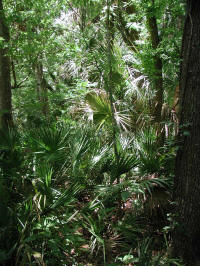 Hammock is a term used in Florida for
closed canopy forests where the most important species are
broad-leaved, evergreen trees. On mesic (moist) or wet (hydric)
sites different types of hammocks occur, and the trees reach much
larger size. Hammocks contain a rich variety of plant species. Hammock is a term used in Florida for
closed canopy forests where the most important species are
broad-leaved, evergreen trees. On mesic (moist) or wet (hydric)
sites different types of hammocks occur, and the trees reach much
larger size. Hammocks contain a rich variety of plant species.
Common broad-leaved, evergreen trees include:
Live Oak, Laurel Oak,Cabbage Palm, Red Bay, Southern Magnolia, Sweet
Bay.
Deciduous trees include:
Hackberry, Elm, Red Mulberry.
In Brevard County, some hammocks have subtropical species of shrubs
that occur near the northern limits of their ranges. Hammocks
protect these frost-sensitive species except during particularly
hard freezes.
Some of these subtropical species include:
Wild coffee, Wild lime, Rapanea, Marlberry, Nakedwood.
Hammocks are shaded and moist compared to the hot, dry scrub. This
allows epiphytes to flourish. Epiphytes are plants that grow on
other plants, not as parasites, but using the host plant as a place
to grow while getting nutrients from rain and dust.
Bromeliads are common epiphytes. Spanish moss (Tillandsia usneoides)
and ball moss (Tillandsia recurvata) are common, and some larger
species such as wild pine (Tillandsia utriculata) occur. Ferns are
another group of epiphytes. Resurrection fern (Polypodium
polypodioides) is common on live oaks. During dry periods,
resurrection fern dries and curls, but soon after rain it expands
and resumes growth. Golden polypody (Phlebodium aureum) and
shoestring fern (Vittaria lineata) occur on cabbage palms. Orchids
are the third group of epiphytes. Green-fly orchid (Epidendrum
conopseum) and butterfly orchid (Encyclia tampensis) are examples.
Hammocks occur on soils that contain more organic matter and
nutrients than soils of scrub or flatwoods. These soils remain moist
most of the time but don't flood for extended periods. Fire does not
occur often in mesic or hydric hammocks because of the moist
conditions and the differences in the structure and type of
vegetation. shallow, fresh water marshes are common in flatwoods.
These flood in the wet season (usually summer) and dry in the winter
or spring. Many grasses and herbs occur in these marshes, and some
of them are important breeding sites for frogs and other amphibians.

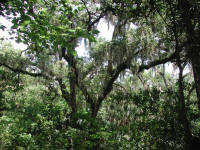 On
mesic (moist) or wet (hydric) sites different types of hammocks
occur, and the trees reach much larger size. Hammocks contain a rich
variety of plant species. On
mesic (moist) or wet (hydric) sites different types of hammocks
occur, and the trees reach much larger size. Hammocks contain a rich
variety of plant species.
Common broad-leaved, evergreen trees include:
• Live Oak (Quercus virginiana)
• Laurel Oak (Quercus laurifolia)
• Cabbage Palm (Sabal palmetto)
• Red Bay (Persea borbonia)
• Southern Magnolia (Magnolia grandiflora)
• Sweet Bay (Magnolia virginiana
Deciduous trees include:
• Hackberry (Celtis laevigata)
• Elm (Ulmus americana)
• Red Mulberry (Morus rubra)
In Brevard County, some hammocks have subtropical species of shrubs
that occur near the northern limits of their ranges. Hammocks
protect these frost-sensitive species except during particularly
hard freezes.
Some of these subtropical species include:
• Wild coffee (Psychotria nervosa & Psychotria sulzneri)
• Wild lime (Zanthoxylum fagara)
• Rapanea (Rapanea punctata)
• Marlberry (Ardisia escallonioides)
• Nakedwood (Myrcianthes fragrans)
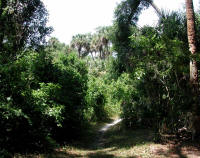 Hammocks
are shaded and moist compared to the hot, dry scrub. This allows
epiphytes to flourish. Epiphytes are plants that grow on other
plants, not as parasites, but using the host plant as a place to
grow while getting nutrients from rain and dust. Hammocks
are shaded and moist compared to the hot, dry scrub. This allows
epiphytes to flourish. Epiphytes are plants that grow on other
plants, not as parasites, but using the host plant as a place to
grow while getting nutrients from rain and dust.
Bromeliads are common epiphytes. Spanish moss (Tillandsia usneoides)
and ball moss (Tillandsia recurvata) are common, and some larger
species such as wild pine (Tillandsia utriculata) occur. Ferns are
another group of epiphytes. Resurrection fern (Polypodium
polypodioides) is common on live oaks. During dry periods,
resurrection fern dries and curls, but soon after rain it expands
and resumes growth. Golden polypody (Phlebodium aureum) and
shoestring fern (Vittaria lineata) occur on cabbage palms. Orchids
are the third group of epiphytes. Green-fly orchid (Epidendrum
conopseum) and butterfly orchid (Encyclia tampensis) are examples.
Hammocks occur on soils that contain more organic matter and
nutrients than soils of scrub or flatwoods. These soils remain moist
most of the time but don't flood for extended periods. Fire does not
occur often in mesic or hydric hammocks because of the moist
conditions and the differences in the structure and type of
vegetation. shallow, fresh water marshes are common in flatwoods.
These flood in the wet season (usually summer) and dry in the winter
or spring. Many grasses and herbs occur in these marshes, and some
of them are important breeding sites for frogs and other amphibians.

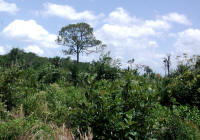 Florida scrub vegetation is a
rare and vanishing ecosystem. Brevard County contains regionally
important scrub ecosystems; these support some of the remaining
populations of the Florida Scrub-Jay (Aphelocoma coerulescens)
and other rare, threatened, and endangered species. Scrub in
Brevard County has been reduced greatly by development; for
example, it is estimated that in Brevard County north of Cocoa
the total area of scrub decreased by 69% between 1943 and 1991. Florida scrub vegetation is a
rare and vanishing ecosystem. Brevard County contains regionally
important scrub ecosystems; these support some of the remaining
populations of the Florida Scrub-Jay (Aphelocoma coerulescens)
and other rare, threatened, and endangered species. Scrub in
Brevard County has been reduced greatly by development; for
example, it is estimated that in Brevard County north of Cocoa
the total area of scrub decreased by 69% between 1943 and 1991.
Florida scrubs typically are
dominated by one or more of four oak species. These oaks are not
trees, but shrubs, rarely exceeding 8' in height. Structurally,
the scrub oaks look similar, but can be identified by their
leaves.
Sand live oak (Quercus geminata), has oblong, evergreen
leaves, about 2-3" long, with curled-under edges and pubescence
(hairiness) beneath.
Myrtle oak (Q. myrtifolia), has shiny, rounded evergreen
leaves, about 2" long, that are glabrous (without hairs)
beneath. (Use the tip of your tongue to feel for pubescence on
leaves.)
Chapman's oak (Q. chapmanii), has larger, deciduous
leaves with various irregular shapes and irregular pubescence.
These three oaks are found in nearly all Florida scrubs.
Inopina oak (Q. inopina), occurs in scrubs in central
Florida only, and usually replaces myrtle oak. The leaves of
Inopina oak are curled and directed upward.
Periodically these bushy oaks are burned to the ground only to
resprout from underground root systems that may actually be more
massive than the above ground parts. The longer a scrub goes
without burning, the larger the scrub oaks become, and if a
scrub is prevented from burning for more that 40-70 years they
(especially sand live oak) will become small trees. The acorns
of the scrub oaks supply food for scrub jays and many other
animals. The scrub oaks are the "backbone" of the Florida scrub.
Saw Palmetto (Serenoa repens)
Saw palmetto is a common feature in many southeastern US
habitats, and is always present in Florida scrub. Saw palmetto
is a creeping palm with a trunk that lies on or just below the
ground surface. Within just 3 days following a fire, palmetto
begins to sprout back from its unburned growing tip. Saw
palmetto looks a lot like scrub palm, the other low-growing palm
in Florida scrubs. Saw palmetto berries are an important food
for many wildlife species including bears, raccoons, possums,
and various insects. The berries also have found a medicinal use
for humans in the treatment and prevention of enlarged prostate
gland.
Scrub Holly (Ilex cumulicola)
Scrub holly is sometimes considered a variety (var. arenicola)
of the wide-ranging American holly (I. opaca). It differs from
American holly in its smaller stature and smaller, narrower
leaves that are yellowish, strongly curled, and held upright.
Scrub holly is restricted to scrubs from Marion County to
Highlands County. Following fire, scrub holly resprouts like
other scrub shrubs, but sometimes it may survive above ground
and start growing again from the top, resulting in a holly that
stands above the scrub's oaks and crookedwood which resprouted
from their roots.
Scrub Olive (Osmanthus megacarpa)
Scrub olive occurs in scrubs, sand pine forests and dry hammocks
throughout central Florida. It is an evergreen shrub or small
tree up to 12' high with shiny green, 3-5" opposite leaves. The
flowers are inconspicuous but pleasantly fragrant, like the
related tea olive (O. fragrans). The fruits are much larger
(over an inch in diameter) than the widespread wild olive or
devilwood (O. americana) of the southeastern United States. (It
is typical for scrub plants to have larger, but fewer, fruits
than their non-scrub relatives.) Our olives are in the same
family (Oleaceae) as the true olive (Olea europaea) of the
Mediterranean region, but for some reason ours haven't been
cultivated for food.
Features uniting these types include:
-
a shrub layer of evergreen, shrub species including Myrtle oak,
Chapman oak, Sand live oak, Staggerbush, Rusty lyonia, Shiny
blueberry, Saw palmetto and Florida rosemary;
-
occurring on well-drained sites on sandy soils low in nutrients;
and
-
burning in periodic, intense fires.
Scrub Indicator Species
Animals that occur in scrub include:
-
Gopher Tortoise — Gopherus polyphemus
-
Florida Scrub Lizard — Sceloporus woodi
-
Eastern Indigo Snake — Drymarchon corais couperi
-
Florida Scrub Jay — Aphelocoma coerulescens
-
Florida Mouse — Podomys floridanus
All of these are on threatened or endangered animals lists.
Scrub Communities
The major types of scrub communities are described below.
Sand Pine Scrub. Sand pine scrub has a closed to scattered
canopy of sand pine (Pinus clausa) and an understory of myrtle,
Chapman, and sand live oaks, saw palmetto, rusty lyonia, and
other shrubs. Florida rosemary may occur. In Brevard County,
sand pine scrub is found primarily on the mainland on higher
ridges of the Atlantic Coastal Ridge.
Rosemary Scrub. Rosemary scrub (rosemary bald) is typically an
open shrubland dominated by Florida rosemary with numerous open,
sandy areas. In Brevard County, rosemary is found with sand pine
scrub and some oak scrub on the Atlantic Coastal Ridge, but
areas dominated by rosemary are rare.
Oak-Saw Palmetto Scrub. Oak-saw palmetto scrub is a shrubland
dominated by Scrub oaks, Saw palmetto, and shrubs in the heath
family including Rusty lyonia, Staggerbush, Shiny blueberry,
Setterbush (Lyonia lucida), and Tarflower (Befaria racemosa).
Associated species may include Florida rosemary, Scrub hickory (Carya
floridana), and Wiregrass (Aristida stricta).
Xeric hammocks are closely related to
scrub communities. Xeric hammock is a closed canopy forest of
relatively low height with a canopy typically of scrub oaks (Quercus
geminata, Q. myrtifolia, Q. chapmanii), and an understory of saw
palmetto (Serenoa repens). In some cases live oak (Quercus
virginiana) may form the canopy. Other scrub shrubs may be present
and may reach small tree size (e.g., rusty lyonia [Lyonia ferruginea],
scrub hickory [Carya floridana]).
Xeric hammocks occur on scrub sites, that is, ridges with
well-drained, low-nutrient, sandy soils. Xeric hammocks occur
naturally where some landscape feature such as a river or lake
prevented the spread of fire and allowed scrub oaks to reach
fire-resistant size. Fire suppression and landscape fragmentation
have allowed much scrub vegetation to develop toward xeric hammock
conditions.

A seasonally flooded, shallow
freshwater marsh found in depressions, sloughs, finger glades & the
floodplains or margins of lakes, streams and rivers.
Wet Prairie habitat & the transitional areas from a Wet Prairie
habitat to the surrounding, habitat are rich in species diversity.
Wet Prairies are also an excellent example of the difference that
small changes in elevation can have on the type of habitats found in
Florida.
Plants common to Wet Prairies - St. John's Wort's, Sedges, Muhly
grass, Sawgrass, Groundsel bush, Wax Myrtle, Sundews, Meadowbeauty,
Marshpink, Switchgrass, Coreopsis.

As the name implies the dominate species is the Sabal palm.
Understory plants include vines, grasses, ferns and various
herbaceous plants, which are determined primarily by the type of
soil and available moisture.

|